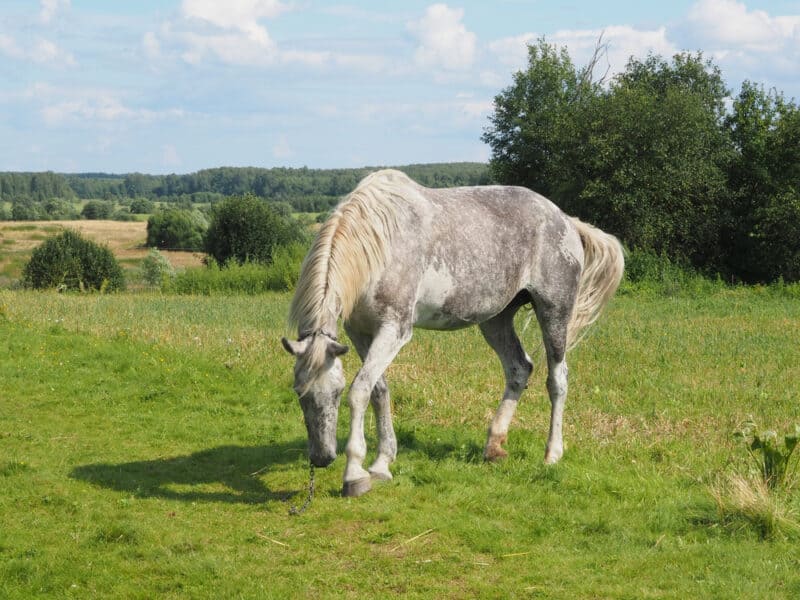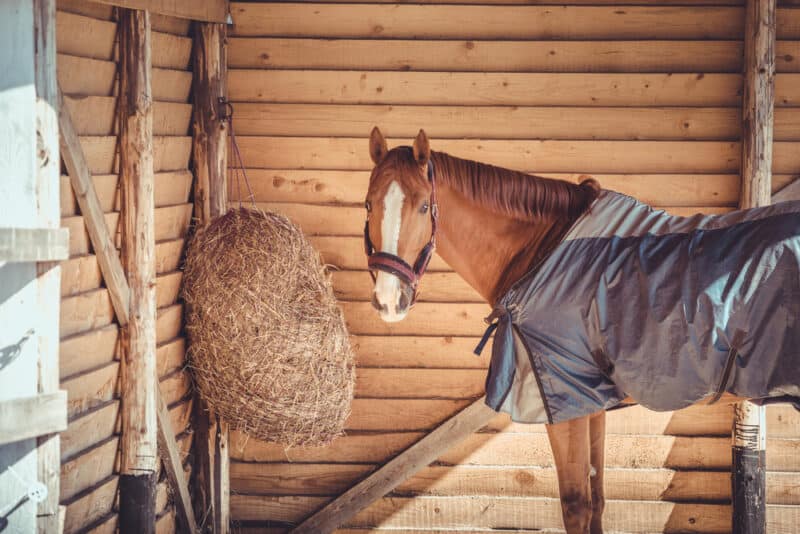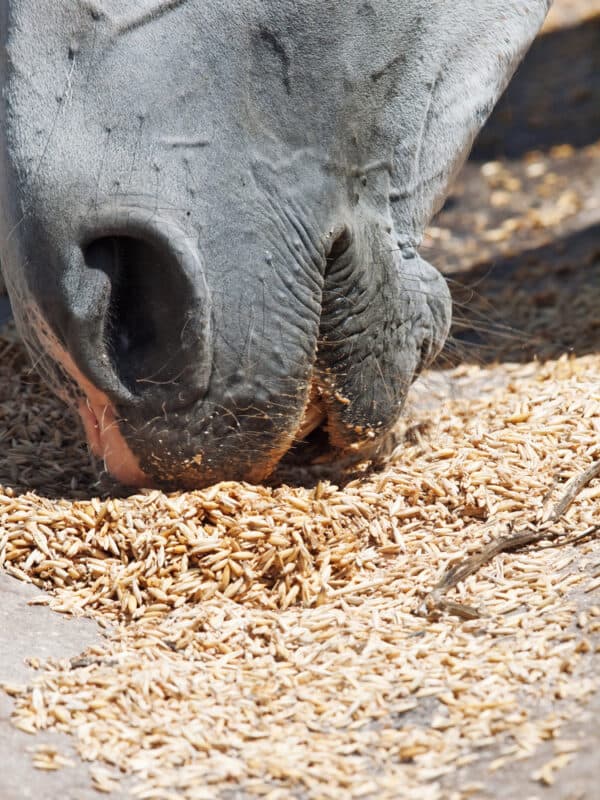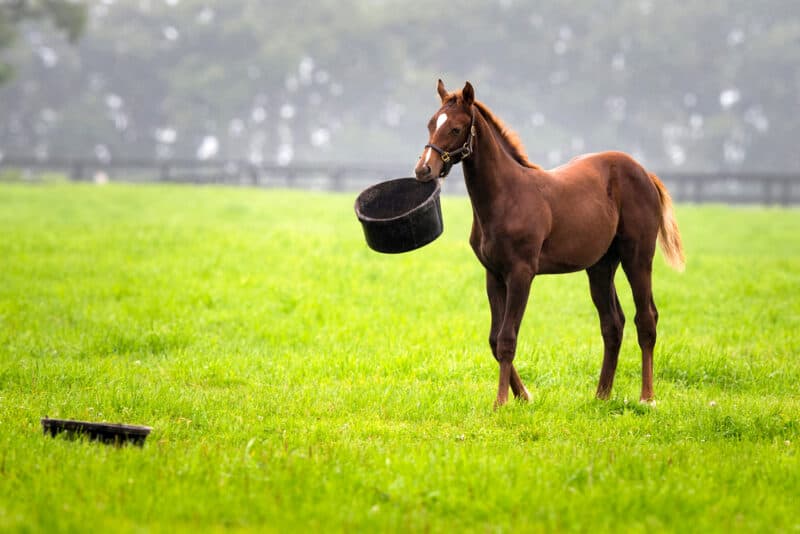What Does Feeding Mean for Horses
If you buy an item via links on this page, we may earn a commission. Our editorial content is not influenced by commissions. Read the full disclosure.
When I was 12 years old, my neighbor offered me a job mucking out stalls at her barn. With the money I made, I paid for riding lessons on my neighbor's older Appaloosa. But the experience taught me a lot more than basic dressage. Specifically, a horse needs the right feed to be healthy, and every horse has individual needs.
Each horse at the stable had a different feeding plan. They grazed in the big pasture most days, but in their stalls they were given hay, water, and varying amounts of grain. Their owners specified supplements or medications to their feed as well.
When feed is out of balance, horses can develop lasting health issues like colic, founder, and infections. It's vital to get it right.
Horse Feed Essentials
Horses are grazing herbivores, like cows, sheep, and other hoofed, four-legged animals. They have evolved to eat all day long. But unlike ruminants like cows, sheep, and goats, horses only have one stomach. Their digestive system is something of an intermediary between that of other non-ruminate herbivores and ruminates like cows and goats.
Horses just have one stomach, but they do much of their digestion before the food reaches the hindgut, or large intestine. The hindgut contains a lot of important microbes that further aid digestion.
Unlike ruminates, horses can't burp. If gasses start building up in their stomachs, horses have a hard time releasing it.
Horses, like their ruminate fellow grazers, need a lot of roughage and only a little grain. In fact, if your horse has consistent access to quality hay and grazing, isn't doing any heavy work, and isn't in a challenging period of life, he might not need any grain at all.
Of course, most of our pastureland is lacking one nutrient or another. If you're a new horse owner, it's better to play it safe. That doesn't mean you have to feed grain, but don't trust pasture and hay to provide all your horse needs to thrive.
Believe me, nutrient deficiencies can be devastating. Here in New England, one of the biggest concerns is selenium deficiency. In your area, it may be copper, potassium, or magnesium. When you're just starting out, it's not easy to know how to spot a deficiency early enough to correct it. So err on the side of caution and keep your horse happy, healthy, and ready to ride by supplementing their pasture.
Pasture & Hay

Ideally, most of your horse's food should come from good pasture. Horses evolved to graze all day long. Like all grazing animals, horses have adapted to spend most of their non-working hours eating. They're built to digest small amounts of food almost constantly, instead of larger meals spread throughout the day.
Left to their own devices, horses will slowly and casually munch their way through the day. Grazing animals should consume about 1.5%-2.5% of their body weight in roughage each day, and they should consume it slowly over hours.
A 500 lb pony is going to need about 10 lbs of roughage while a 1000lb horse will be eating closer to 20lbs. If your horse is only grazing 8 hours a day, it's a good idea to offer some hay in his stall as well. But if your horse is living in pasture, and grazing as often as he wants, he may or may not need supplemental hay.
How Can I Know if My Horse Needs Hay?
If your horse is only on pasture for 8-10 hours each day, it's likely he needs hay in his stall as well. On average, a 1000lb horse will consume about 1/3 of his daily intake in 8 hours of grazing. So for the other 2/3 of the day, offer him the remaining 13lbs of roughage as hay in his stall. Draft horses will require even more food!

The more time he spends grazing, the less he needs access to hay. But of course, pasture changes throughout the seasons. In winter, this same horse may need all 20lbs of roughage given as hay each day.
For most horse owners, hay is an essential part of everyday feeding even in the summer. Not many of us have the pasture necessary to keep a horse healthy without supplementing. A horse needs a minimum of 1.5-2 acres of well-managed pasture to thrive without supplemental roughage.
You must also consider the weight of your horse. If she is looking a bit thin, supplemental hay and a little grain can help. If she is on the chunky side, she might not need any supplemental hay.
Some horses have a hard time keeping on weight, while others get fat just thinking about food. They're kind of like humans in that way. Keep your horses' type in mind when deciding on what to feed.
Also, be sure to know what plants are poisonous to horses and pluck them immediately if you see them out in your pasture.
Choosing Hay
There is a huge difference between varieties of hay. A diet of alfalfa and clover is too rich for most horses, while bales of weeds, goldenrod, and some grasses might make a horse turn up his nose. For most horses, a simple grass hay like timothy or orchard hay is ideal.
Select bales that are pale or light green. Some hays can even be deep green, such as alfalfa. Brown bales are too old and the nutrients are gone. Avoid bales with gray, white, or black patches. Those spots indicate a moldy bale. You should also avoid bales that smell musty or dank. Hay is dried grass – it should have a fresh, grassy scent.
An average bale of hay weighs about 40-75. That's a wide range, so don't trust each bale will offer a consistent amount of feed. Even from the same farmer, each bale is different. Hay is divided into flakes. Typically, these flakes are around 5-7 lbs, each, but this can vary as well.
Water and Minerals

Water is a huge part of keeping your horse healthy. Horses are large animals, and they need a lot of water to keep themselves hydrated. On average, a horse will drink 5-10 gallons of water each day. Horses grazing on pasture drink less than those eating hay because hay is drier than fresh grass. In hot weather, or after heavy work, horses tend to drink more than they would on lazy, cool days.
Try to keep fresh, clean water available to your horse at all times. Ideally, a stream running through the pasture will make hydrating your horse simple. But there's no shame in hauling buckets to refill the water trough either.
Near the water, offer a salt and mineral lick, or a dish of loose, trace minerals. These blends not only provide for your horse's salt needs but can even out whatever your pasture and roughage lack. Trace minerals that are depleted in the soil are easy for horses to access in mineral blocks, which keeps your horse safe from the devastating effects of selenium, magnesium, and potassium deficiency.
If you haven't been offering your horse supplemental salt and minerals, introduce them slowly at first. Horses that are low on one or two minerals may go overboard when they're first offered trace minerals. Start with a sprinkle of trace minerals on top of hay, or in a pail. Give a limited amount of minerals for at least a week before leaving a free-access block in the pasture.
Some people opt to put minerals on top of something enticing like grain or beet pulp, since many horses will turn up their nose as vitamins and supplements.
What About Grain?
Lightly worked horses rarely need supplemental grain. With quality roughage, access to minerals, and plenty of water, grain is hardly necessary. But sometimes, based on activity level, quality of pasture and hay, and even harsh weather, a little grain can go a long way.
When feeding grain, it's important to choose one formulated for horses. Start with a small amount of grain and work up as you're introducing it. Even horses who do require a little boost rarely need more than 1-2 lbs of grain per day. You should never go above 10 lbs of grain for any horse, because increased grain can cause an increased risk of colic.
Spread out feedings to prevent your horse from stuffing himself, too.

Grain is exciting for animals. Imagine a kid in a room full of candy. Make sure to store your grain in a sealed container, inaccessible to horses. If you're feeding more than one horse at a time, keep an eye on them as they eat and set out two buckets of feed, so that the more submissive horses have a chance to eat as well.
It's ideal to feed roughage first, and only afterward offer grain. It's sort of like eating a salad before starting in on richer foods. Roughage helps the horse digest the grain better and it discourages overeating or eating too fast. Treat grain as a supplemental feed, and not the primary source of nutrients or calories.
Change Slowly
No matter what changes you make to your horse's diet, do it slowly. Even increasing pasture should be done slowly to prevent your horse from foundering with the increase of sweet, fresh grass. Don't rush any changes you make to your horse's life and feeding. Even if the changes are essential, it's safer to take time to shift feeding practices.
A good practice is to make any dietary changes over a period of 1 or 2 weeks. This slow, gradual shift helps reduce the chances of colic or founder in your horses. Slow and steady really does win this race.
Also, this slow change rule applies to offering treats, as well. It's fine to give your horse carrots, apples, or other treats, but introduce them slowly. Too many all at once and you could make your horse sick.
Was this article helpful?
Yes No
jettonoripsensfuld.blogspot.com
Source: https://morningchores.com/feeding-horses/
0 Response to "What Does Feeding Mean for Horses"
Postar um comentário